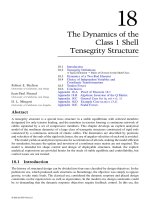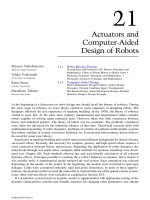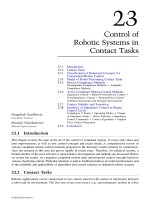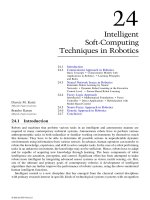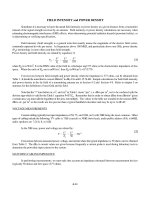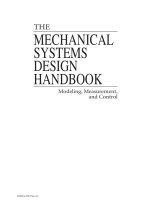Tài liệu Modeling, Measurement and Control P29 doc
Bạn đang xem bản rút gọn của tài liệu. Xem và tải ngay bản đầy đủ của tài liệu tại đây (5.14 MB, 15 trang )
was achieved. The decision to invest in a robot system for the complicated process of sealing and
assembling variable frames turned out to be more profitable than originally estimated.
28.3 Service Robots
28.3.1 From Industrial Robots to Service Robots
Early industrial robots were found in many nonmanufacturing applications:
• Inspection tasks in hazardous environments
• Laboratory automation
• Automated pharmacy warehousing
• Storage and retrieval of data cartridges in computing centers
FIGURE 28.21
Preassembly cell (top) and
final assembly cell (bottom) with flexible clamping system.
© 2002 by CRC Press LLC
Robot application in nonmanufacturing fields has been on the rise as key technologies have become
more available. Sensors in combination with advanced perception algorithms allow robots to function
in partly or even completely unstructured environments. Fast interactions between sensing and action
account for effective and robust task execution, even in dynamically changing situations.
A definition recently suggested by IFR (the International Federation of Robotics) offers a
description of the main characteristics of service robots, their exposure to public, and task execution
in unstructured environments.
15
Service robots are considered extensions of industrial robots.
19
Service robots are robots which operate semi or fully autonomously to perform services useful
to the well being (hence, non-manufacturing) of humans and equipment. They are mobile or
manipulative or combinations of both.
IFR has adopted a preliminary system for classifying service robots by application areas:
• Servicing humans (personal, safeguarding, entertainment, etc.)
• Servicing equipment (maintenance, repair, cleaning, etc.)
• Performing autonomous functions (surveillance, transport, data acquisition, etc.) including
service robots that cannot be classified in the previous categories.
Some scientists and engineers even predict a future for “personal robots,”
5,7
and visions depict
these robots as companions for household tasks, gardening, leisure, and even entertainment. The
evolution of robots can be characterized by the level of machine intelligence implemented for task
execution. See Figure 28.22.
17
28.3.2 Examples of Service Robot Systems
Service robots are designed for the execution of specific tasks in specific environments. Unlike an
industrial robot, a service robot system must be completely designed. New concepts stress the
possibility of using preconfigured modules for mechanical components (joints) and information
processing (sensors, controls). The following is a survey of different service robot systems, based
on the IFR classification scheme.
FIGURE 28.22
From industrial robots to service robots — the evolution of machine intelligence.
© 2002 by CRC Press LLC
Servicing humans —
The medical manipulator (MKM) produced by Carl Zeiss, Germany,
consists of a weight-balanced servo-controlled six-DOF arm, a computer control, and a graphical
workstation for visualization and programming. It carries a surgical microscope. Movements follow
preprogrammed paths or are generated manually by a six-DOF input device (space-mouse) or voice.
The MANUS arm of Exact Dynamics, The Netherlands, is a wheel-chair mountable six-DOF
lightweight manipulator meant for persons with severe disabilities. The combination of wheelchair
and manipulator helps in executing simple tasks such as opening doors, preparing coffee, etc. The
arm folds discreetly while not in use. The man–machine interface for motion command can be
individually adjusted to the person’s abilities and can be a mouth whistle, voice, joystick, or any
other adequate device.
MKM
MANUS
© 2002 by CRC Press LLC
CASPAR (Computer Assisted Surgical Planning and Robotics) of ortoMAQUET, Germany,
consists of an industrial robot mounted on a mobile base, a milling tool, and a calibration unit.
The system assists the surgeon in orthopedic interventions such as hip surgery. On the basis of
patient data, the placement of a hip prosthesis is simulated. All contours for a perfect fit are milled
with remarkable precision under surgical supervision.
Electrolux, Sweden, introduced the first lawn mower powered by solar cells. Some 43 solar cells
transform sunlight into electrical energy. The solar mower is fully automatic and eliminates emis-
sions into air and makes almost no noise.
CASPAR
Electrolux
© 2002 by CRC Press LLC
Servicing equipment —
With two Skywash systems (Putzmeister Werke, Germany) in parallel
operation, a reduction of ground times per washing event for factor 3 (wide body) aircraft and
factor 2 (narrow body) can be achieved. Skywash integrates all features of an advanced robot
system: pregeneration of motion programs by CAD aircraft models, object location by 3D-sensors,
tactile sensor-controlled motion, redundant arm kinematics (11 DOFs) installed on a mobile base,
and full safety features for maximum reliability. From a rough placement relative to the aircraft,
Skywash operates under human supervision.
A master–slave two-armed robot (Yaskawa, Japan) carries out operations with live wires (cutting,
repair, etc.) of up to 6600 V capacity. A truck-mounted boom carries the manipulator arms which
are operated from a cabin.
Skywash
Master–slave two-armed robot
© 2002 by CRC Press LLC
Rosy produced by Robot System of Yberle, Germany, climbs surfaces on suction cups to perform
cleaning, inspection, painting, and assembly tasks. Tools can be mounted on the upper transversal
axis. Navigation facilities allow accurate and controlled movements.
A robot for nuclear reactor outer core inspection (Siemens KWU, Germany) follows a modular
approach. Each joint module with common geometric interfaces houses power and control electronics,
an AC servo drive and a reduction gear. The robot travels along existing rails and maps the core
surface by its end effector-mounted ultrasound sensors. Material flaws can be detected and moni-
tored during reactor operations.
Rosy
Robot for nuclear reactor outer core inspection
© 2002 by CRC Press LLC
